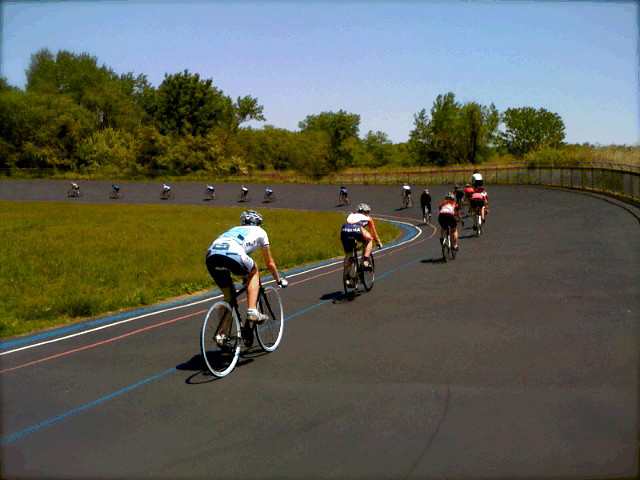Interview: Joe
Brennan on Women’s Track Racing
By Minda Aguhob

How did you get
involved in track racing?
I started racing track
in the 1970s at Kissena. Trexlertown didn’t even exist at the time.
Back then everything was run by Al Toefield who would park his orange
van on the infield. Racing was friendly, but hard — just like it is
today.
I started promoting
track events about 15 years ago and even had a brief stint as the
race director at the San Diego Velodrome. Promoting races and clinics
can be a lot of fun. You get to use a lot of creativity, and you get
to try the ideas that you always said other promoters should do.
Often, you find out why other promoters don’t do those things.
How did you get
into running women’s track clinics at Kissena?
I promoted a couple of
co-ed clinics at Trexlertown which were fairly successful. The first
women’s clinic was a bit of an experiment. Kissena has always had
organized coaching run by John Campo on Saturdays. We decided to try
a women only clinic to spark some interest. The response was better
than expected, so we’ve been doing them again.
It’s not that a
women’s clinic is different than any other, but it’s easier to manage
a group with similar power levels. And, in a co-ed environment the
guys tend to get the most attention, and the women often get pushed
to the side. At the women only clinics, the women are the primary
focus and that’s very appealing. The Forest City Velodrome in Ontario
has also had similar success and has built a formidable women’s
program.
Do you have a
coaching philosophy?
If I have a
philosophy, it’s that I don’t consider myself to be a coach — I’m
more of a facilitator. People learn much more by doing something than
being told how to do something. So, if someone wants to learn how to
ride Match Sprints, then they should ride Match Sprints. It’s amazing
how quickly people learn on their own.
What do you think
of women’s track now and in the future?
Kissena has had a lot
of growth over the last few years. John Campo, the track director,
has recruited a lot of riders to the track; and our safe, well
organized races, run by Alan Atwood, have kept people coming back.
The program has been so successful that, in 2008, we’ve moved to two
nights of racing. This has been a windfall for the women. Instead of
only two races and a chance to ride in a men’s final, women now get
at least three races.
We’ve already had
larger women’s fields than on any day last season. Like the guys,
most of the women are good road riders who race at the track for the
additional competition. I expect to see the women’s fields to
continue to grow. The friendly environment combined with women only
races makes Kissena Velodrome very appealing to women riders in the
New York area.
What problems do
women have moving over to track?
The number one problem
is finding bikes that fit. Taller women can easily find new and used
bikes that work well. The smaller girls have slim pickings. Many
manufactures “cheat” when making smaller bikes by just
making the seat tube shorter or by increasing the seat tube angle to
make the bike seem shorter, but ultimately the bikes are too long. A
few companies make 650c bikes which I think is a much better
solution.
The challenge that men and women road riders have
when they start racing track is the variation in cadence. At some
points in a race you could be at 75RPM and then have to accelerate.
In a sprint, 125RPM would not be uncommon. It takes a little time,
but your body gets used to it. Although the new riders don’t know it
yet, the added low RPM power and added peak cadence, will
significantly enhance their road racing. It’s like adding two new
weapons to their arsenal.

What does a typical
track workout look like?
Here’s a typical
sprint workout. I learned it 30 years ago, and the guy who showed it
to me learned it 30 years before that.
-
Warm-up
(20 minutes)
-
Dead
Starts – 88″ gear, 100 meters with only one foot in the pedals
from a dead stop. Twice with each leg.
-
Telephone
pole jumps – 75″ – 80†gear, start at 75 rpm,
Accelerate for one telephone pole (about 50 meters), slow down for
two telephone poles, and repeat (3 sets of 5, with 3-5 minutes rest
in between sets). Alternate in the saddle vs. out of the saddle.
Effort level is 80%. On the track, use the backstretch for the
acceleration, and use the remainder of the lap to slow down.
-
Rest
(5 – 10 minutes)
-
Sprints
– 200 meters. 88″ gear. Start off a slight decline, like half
way down an overpass or off the banking of the track. Effort level
is 100%. 10-15 minutes rest in between each sprint. One set of 5
sprints.
How do you get
started racing track in general?
There are several ways
to get started: Come out to our Saturday noon – 2PM sessions. Come
out to our races on Wednesdays for men and on Mondays for women,
masters and juniors. Experienced road riders generally have no
problem going right into races. For women, we are holding another
clinic on June 22, and perhaps another in a month or so. For all
events, we have a limited number of loaner bikes. Information on
events and how to register can be found at www.kissena.info.
